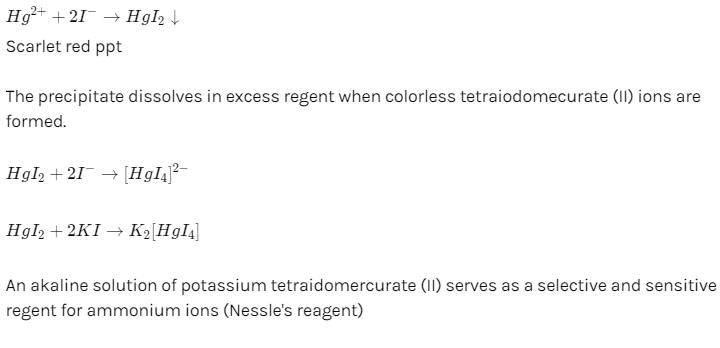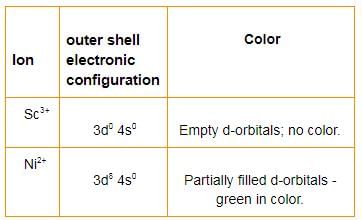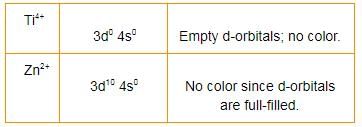Test: General Properties of d-Block Elements - NEET MCQ
25 Questions MCQ Test - Test: General Properties of d-Block Elements
Only One Option Correct Type
Direction (Q. Nos. 1-10) This section contains 10 multiple choice questions. Each question has four choices (a), (b), (c) and (d), out of which ONLY ONE is correct.
Q.
Atomic number of second transition series lies from
Which has lower standard reduction potential (SRP) value?
An element has configuration 4d55s2. The element belongs to
The electronic configuration of palladium is
Which has lowest and highest first ionisation enthalpy in 3d series?
The electronic configuration of the element which is just above the element with atomic number 42 in the same group
Which one of the following exists in the oxidation state other than +3?
Electronic configuration of a transition element X in +3 oxidation state is [Ar] 3d5 and Y in +2 state is [Ar] 3d8. What are the atom ic numbers of the elements?
The atomic radii of Cu and Ag are 1.17 Å and 1.34 Å. The atomic radius of gold is expected to be
A red solid is insoluble in water. However, it becomes soluble if some KI is added to water. Heating the red solid in a test tube results in liberation of some violet coloured fumes and droplets of a metal appear on the cooler parts of the test tube. The red solid is
One or More than One Options Correct Type
Direction (Q. Nos. 11-15) This section contains 5 multiple choice questions. Each question has four choices (a), (b), (c) and (d), out of which ONE or MORE THAN ONE are correct.
Q. Identify the pairs in which one covalent radii of elements are almost similar.
Which one is of the following is the lightest transition element?
Which of the following have pseudo noble gas configuration?
Which one of the following is a diamagnetic ion?
The pair of ions that have same electronic configuration
Comprehension Type
Direction (Q. Nos. 16 and 17) This section contains a paragraph, describing theory, experiments, data, etc. Two questions related to the paragraph have been given. Each question has only one correct answer among the four given options (a), (b), (c) and (d).
Passage
The atomic and ionic radii for transition elements are smaller than their corresponding s-block elements and are greater than their corresponding p-block elements. The atomic and ionic radii transition elements for a given series show decreasing trend for first elements constant in the middle and slight increase towards the end. This is due to the combined effect of increasing effective nuclear charge and increasing screening effect along the period.
The atomic and ionic radii of 4d series are greater than 3d series. However, the elements of 4d series and 5d series have almost similar sizes due to lanthanide contraction. Transition elements have low atomic volumes, high densities, high melting points.
Q.
Which pair of elements has nearly same atomic size?
Passage
The atomic and ionic radii for transition elements are smaller than their corresponding s-block elements and are greater than their corresponding p-block elements. The atomic and ionic radii transition elements for a given series show decreasing trend for first elements constant in the middle and slight increase towards the end. This is due to the combined effect of increasing effective nuclear charge and increasing screening effect along the period.
The atomic and ionic radii of 4d series are greater than 3d series. However, the elements of 4d series and 5d series have almost similar sizes due to lanthanide contraction. Transition elements have low atomic volumes, high densities, high melting points.
Q.
The metal with high melting point in 3d series is
Matching List Type
Choices for the correct combination of elements from Column I and Column II are given as options (a), (b), (c) and (d), out of which one is correct.
Q.
Match the Column I with Column II and mark the correct option from codes given below.
Which one of the following ions exhibits colour in aqueous solution
One Integer Value Correct Type
Direction (Q. Nos. 20-23) This section contains 4 questions. When worked out will result in an integer from 0 to 9 (both inclusive).
Q.
The number of elements that do not have completely filled d subshell among the elements Ni, Pd, Pt, Cu, Ag, Au, Zn, Cd and Hg are
Total spin of the electrons in a chromium atom is
Number of electrons with l = 2 and s = 1/2 in zinc atom are
Number of elements that generally do not show variable valencies Cu, Zn Au, Cd, Sc, La, Pt, Co.
During the process of electrolytic refining of copper, some metals present as impurity settle as ‘anode mud’ These are
Statement Type
Direction (Q. No. 25) This section is based on Statement I and Statement II. Select the correct answer from the codes given below.
Q.
Statement I : The highest oxidation state of osmium is +8.
Statement II : Osmium is a 5-d block element.

















